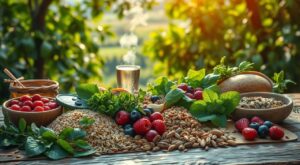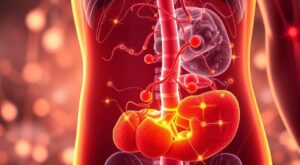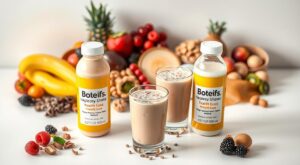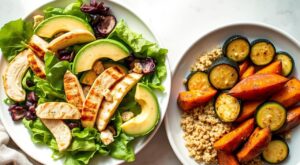Ever thought a healthy meal plan could lead to quick weight loss in a week? It’s true! Following a structured, nutritious plan can help you lose weight fast and feel great. We’ll show you how to make a balanced diet that’s tasty and supports your health and fitness goals.
Understanding the Importance of Meal Planning
Meal planning is key to reaching your weight loss goals. It helps you eat mindfully and avoid bad food choices. Planning your meals makes it simpler to eat healthily and stay on track.
Benefits of Meal Planning for Weight Loss
Meal planning for weight loss has many benefits:
- Improved nutrient intake: You can pick foods rich in nutrients, getting all the vitamins and minerals you need.
- Calorie control: Knowing your meals helps you avoid too many calories and stick to your daily calorie goals.
- Time savings: Preparing meals ahead of time saves you time on busy days, letting you do other things.
How to Create Your Meal Plan
To make a good meal plan, follow these steps:
- Figure out how many calories you need each day for your weight loss goals.
- Choose foods that are good for you, like lean proteins, whole grains, and lots of fruits and veggies.
- Add snacks to keep you full all day.
- Make your plan flexible so you can change it if needed.
Tips for Sticking to Your Plan
Here are ways to stay on track with your meal plan:
- Track your progress: A food diary helps you stay on track and see patterns in your eating.
- Prepare meals in advance: Cooking big batches and portioning out meals saves time and stops you from eating unhealthy foods.
- Find support: Tell your friends or family about your goals. They can support and keep you accountable.
Key Components of a Healthy Meal Plan
Creating a meal plan that focuses on a balanced diet is key to losing weight. A good plan has the right mix of nutrients, controls portion sizes, and makes sure you get enough fiber and water.
Balanced Macronutrients Explained
A good meal plan has the right mix of proteins, fats, and carbs. Proteins help keep your muscles strong and boost your metabolism. Healthy fats are good for your brain and hormones. Complex carbs give you energy for the day.
Knowing how to balance these nutrients is important. It helps you make low-calorie meals that meet your nutritional needs. For more info on balancing macronutrients, check out this resource.
Portion Control Basics
Learning to control your portions is key to managing calories. This way, you can enjoy different foods without eating too much. Use smaller plates, measure your food, and listen to your body’s hunger signals.
Pre-portioning your meals and snacks can also help keep you on track.
Importance of Fiber and Hydration
Fiber is great for your digestive health and keeps you feeling full. Aim for 25–30 grams of fiber a day from fruits, veggies, and whole grains. Drinking 2–3 liters of water a day helps with hunger control and overall health.

| Macronutrient | Source Examples | Caloric Value |
|---|---|---|
| Proteins | Chicken breast, fish, lentils | 4 calories/gram |
| Fats | Avocados, nuts, olive oil | 9 calories/gram |
| Carbohydrates | Quinoa, brown rice, fruits | 4 calories/gram |
A Quick Look at Nutrient-Dense Foods
Nutrient-dense foods are key for those aiming for healthy meal plans for weight loss. They offer lots of nutrients but not many calories. Knowing what these foods are helps you choose better for a balanced diet and weight control.
What Are Nutrient-Dense Foods?
Nutrient-dense foods have lots of nutrients for not many calories. They include many healthy ingredients that feed your body well. Eating these foods means you can enjoy tasty meals that are good for you.
Examples of Nutrient-Dense Foods
Adding different nutrient-dense foods to your diet makes your nutritious meal plans better. Some great choices are:
- Leafy greens, such as spinach and kale
- Whole grains like quinoa and brown rice
- Legumes, including lentils and chickpeas
- Nuts and seeds for healthy fats
- Lean proteins such as chicken, fish, and tofu
For more tips on using these foods, check out this guide on top diets that focus on whole foods.
Benefits of Including These Foods
Adding nutrient-dense foods to your meals helps you feel full and stay healthy. They give you important vitamins and minerals without too many calories. This makes it easier to keep your energy up and reach your weight loss goals.
Your 7-Day Healthy Meal Plan Overview
This 7-day meal plan is a practical guide for your weight loss journey. It’s designed for a daily caloric intake of 1,500 to 2,000 calories. This plan includes a variety of meals and snacks, making meal prep fun and effective. Planning meals can also reduce stress and help you stick to your weight loss plans.
Daily Caloric Goals
Setting daily caloric goals is key to a healthy lifestyle. Aiming for 1,500 to 2,000 calories a day supports slow weight loss. This amount gives you enough energy and helps with fat loss when you eat nutritious foods.
Variety and Repetition in Meals
Having a variety of meals in your week prevents boredom. Think of repetition as a chance to make meal prep easier. Enjoying your favorite dishes can make cooking simpler, while trying new recipes keeps things exciting. Finding a balance between the two can help you stick to your meal plan.
Timeline for Transition
Starting this 7-day meal plan needs careful planning. Begin by slowly changing your portion sizes and how often you eat. This gradual adjustment helps your body get used to new habits. Aim for small changes that make adopting this meal plan rewarding and natural.

Day 1: Energizing Kick-off Meal Plan
Starting your week with a good meal plan is key. It helps you stay on track with your goals. The meals below are designed to keep you energized all day. They’re part of a plan that makes you feel full and alive.
Breakfast Ideas
Start with an Egg and Avocado Pita. It’s packed with protein and healthy fats. A pinch of salt and pepper adds great flavor.
Lunch Suggestions
For lunch, try a Chicken Quinoa Bowl. It’s lean and filling, with just the right amount of calories. Add bell peppers and spinach for extra nutrients. This meal keeps you full and supports your weight loss goals.
Dinner Recipes
End your day with Instant Pot Chicken Soup. It’s quick, nutritious, and comforting. Add carrots and celery for extra vitamins. This soup is perfect for your dinner plans.

Day 2: Building on Success with Flavorful Meals
On Day 2, you’re diving into delicious flavors while keeping your weight loss goals in mind. Each meal is made to please your taste buds and fit into low calorie plans. This way, every bite is good for you.
Breakfast Boosters
Begin your day with Overnight Oats. It mixes rolled oats with almond milk, topped with fresh fruits and chia seeds. It’s packed with whole grains and nutrients, giving you the energy to start your day. You can also add your favorite fruits or cinnamon for extra flavor.
Satisfying Lunch Options
For lunch, try a Roasted Chickpea, Tomato, and Chicken Bowl. It has protein-rich chicken and fiber-rich chickpeas, keeping you full. Add mixed greens and a light vinaigrette for more flavor. This meal is great for your weight loss diet.
Wholesome Dinner Choices
End your day with a Baked Salmon with Spring Vegetables. It’s full of healthy fats and pairs well with asparagus and carrots. This meal is both nourishing and tasty, fitting your low calorie plans.

Enjoy these tasty meals as you continue your journey to a healthier lifestyle. Each day will be delicious and help you reach your goals.
Day 3: Midweek Motivation with New Recipes
On Day 3, you’ll discover new flavors and ideas to spice up your weight loss meal prep. Adding creativity to your meals makes following effective weight loss plans more fun. Let’s explore some tasty options for breakfast, lunch, and dinner.
Creative Breakfast Combinations
Begin your day with a twist on a classic. Try a Souped-Up Almond Butter and Jelly toast. It’s packed with protein and fiber, making it a great morning choice. Spread almond butter on whole-grain bread and add a thin layer of fruit jam or fresh berries.
This dish fuels your day and fits perfectly into your weight loss meal prep.
Healthy Lunch Wraps
For lunch, make a Salmon Niçoise Salad using leftovers from Day 2. This salad has nutritious greens, olives, boiled eggs, and salmon. It’s a balanced meal full of omega-3 fatty acids and vitamins.
Using leftovers saves time and resources, keeping your meal prep efficient and effective.
Filling Dinner Delights
End your day with a Sheet Pan Roasted Chicken. It’s easy to make and full of flavor. Season chicken breasts with herbs and roast with veggies like carrots and broccoli.
This one-pan dish is easy to clean up. It’s a nutritious meal that supports your weight loss goals.
Days 4-7: Final Steps to Success
Days 4 through 7 are all about recovery, trying new things, and celebrating. Each day, you’ll stick to healthy meals and keep your taste buds happy.
Day 4: Recovery and Refueling
Day 4 is for taking care of your body. Choose light, nutritious foods like *Quinoa and Veggies.* These meals help your body recover without feeling too full.
Day 5: Reinventing Your Favorites
Day 5 is all about making old favorites healthier. Try dishes like *Herbed Shrimp and Watercress Salad.* It’s a tasty way to stay on track with your healthy eating.
Day 6: New Culinary Adventures
Day 6 is for trying new recipes. Explore dishes with lots of healthy ingredients. It keeps your meal plans exciting and helps you stay on track.
Day 7: Celebrating Your Progress
Day 7 is for celebrating your hard work. Enjoy your favorite meals from the week. It’s a great way to keep a positive mindset and support lasting healthy habits. For tips on keeping weight off, tracking your progress is key.
Essential Tips for Meal Prep
Effective weight loss meal prep can change how you plan meals for weight loss. These tips help you create a plan, choose healthy foods, and keep meals fresh and tasty. With a bit of organization, you can make your routine easier and enjoy healthy meals all week.
Shopping List Essentials
Begin with a detailed shopping list. Pick foods that are full of nutrients and help you lose weight. Include:
- Fruits and vegetables
- Lean proteins like chicken, turkey, or fish
- Whole grains such as brown rice and quinoa
- Healthy fats like avocado and nuts
Having these foods ready makes planning meals for weight loss fun and easy.
Preparing Meals in Advance
Prepping meals ahead helps you control portions and avoid unhealthy snacks. Here are some tips:
- Set aside a day for meal prep.
- Cook large amounts to save time.
- Make different meals to keep things interesting.
By using these methods, meal prep for weight loss becomes a simple part of your week.
Storing Leftover Meal Portions
Right storage keeps your meals fresh, helping you stay on track. Use these tips:
- Get airtight containers to keep food fresh.
- Label containers with dates to know when they were made.
- Put meals in the fridge or freezer based on when you’ll eat them.
With these storage tips, you can reduce waste and enjoy your planned meals.
Staying Motivated Throughout Your Journey
Staying motivated for weight loss can be tough. Keeping your motivation up is key to reaching your goals. Tracking your progress helps you see the fruits of your labor. This keeps you focused and determined.
Having a strong support network is also vital. They offer encouragement and keep you accountable. Plus, rewarding yourself for your achievements helps keep you on track.
Tracking Your Progress
Keeping a record of your weight loss journey is insightful. Use a journal or a mobile app to track:
- Your daily food intake
- Exercise routines
- Body measurements
- Weekly weight changes
This reflection shows how far you’ve come. It also helps you see what works best for you.
Finding Support and Accountability
Having a support system makes your journey better. Connect with:
- Friends and family who share your goals
- Online communities focused on healthy living
- Fitness classes or support groups
Sharing your goals with others makes you more accountable. It motivates you to stay committed.
Reward Yourself Healthily
Celebrating your successes doesn’t mean eating more. Instead, try these alternatives:
- New workout gear
- Spa days or self-care moments
- Fun activities or outings
These rewards boost your spirits without ruining your weight loss efforts.
Conclusion: Embracing a Healthier Lifestyle
As you finish your 7-day meal plan, remember the lasting benefits. Meal planning helps you make better food choices and builds healthy habits. These habits help you avoid unhealthy eating in the future.
Creating a meal planning routine is important for a healthy lifestyle. Spend time each week planning meals and preparing ingredients. This makes cooking easier and helps you stay consistent with your nutrition goals.
Think about your journey so far and see this meal plan as just the start. Try new recipes and adjust your plan as you like. Every step towards wellness brings you closer to lasting health and weight loss. Celebrate your progress and keep moving forward!












